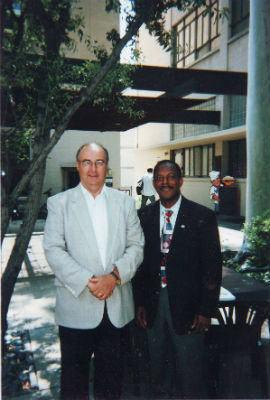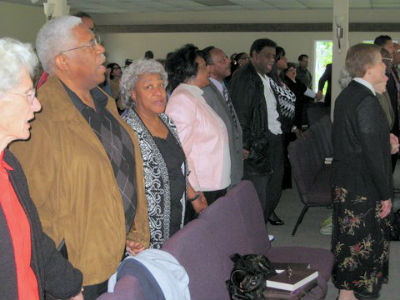The Possible Dream: Walking Where the Long Past Lives
By Neil Earle
 National Civil Rights Museum in Memphis, Tennessee
National Civil Rights Museum in Memphis, TennesseeMemphis, TN: In the midst of two vicious cold spells thousands showed up at the National Civil Rights Museum here in Memphis for the annual commemoration of Martin Luther King Jr.’s birthday on January 15. One moment that captivated USA TODAY NETWORK writer Chris Herrington was the exchange recounted at the museum in a 1960s meeting between federal attorney John Seigenthaler and Dianne Nash. Nash was then a 22-year-old college student organizing the Freedom Rides that challenged state segregation across the south.
“Young woman, do you understand what you’re doing. Do you understand you’re gonna get somebody killed?” asked Seigenthaler.
“Sir,” replied Nash, “you should know we all signed our wills and testaments last night.”
Such was the spirit that animated the Movement that Dr. King led.
 Neil Earle and ORM founder Curtis May
Neil Earle and ORM founder Curtis MayLife’s Ironies
On this day I couldn’t help but reflect how ironic it was that I had been a Memphis citizen since November 14, 2017 in a city which will become a focal point of world attention this April on the 50th anniversary of Reverend King’s assasination here in Memphis. Ironic because I was only a little older than Diane Nash when as a young student walking the halls of Memorial University of far-away Newfoundland on the east coast of Canada, my peers and I were transfixed by the news reports coming out of the U.S. South, by the dramatic clash of dog and protestors, of police and seamstresses, of fire-hoses and paddy wagons that were the stuff of our nightly news.
All of this seemed a light year removed from the quieter pace of student life in Atlantic Canada.
Yet hovering above it all, almost hypnotically, was the soaring rhetoric of Martin Luther King, Jr. – “We will have to repent in this generation not merely for the hateful words and actions of the bad people but for the appalling silence of the good people.” Or how he celebrated each small victory in the spirit of the Montgomery Bus Boycott: “This is not a victory for black Americans; this is a victory for all Americans. Injustice anywhere is a threat to justice everywhere!”
Now there was a man who knew how to cut through the fog.
The Quest to be Reconciled
Years later, after many fits and starts and stumblings and detours in my own life, I found myself pastoring a church in Southern California and in 1999 being asked by my African-American supervisor, Senior Pastor Curtis May, to raise up a newsletter dedicated in some small and very feeble way to the daunting subject of social justice. He knew as I did that this was a project needed in our own church (then-named Worldwide Church of God) as much as anywhere. And the opposition was both subtle and not-so-subtle and, yes, very familiar. “Why are you doing this?” “Aren’t you just raising dead issues?” “Why dredge up past hurts and shames?” And most tellingly: “Isn’t all this designed to make white folks feel guilty?”
We had no fulltime staff, little money and few resources but start it we did and it is hard to believe we’re still in action, mainly through our website “ATimetoReconcile.org.” Almost twenty years have passed since the first issue of our “Reconcile” newsletter came out in humble black and white titled “Church Opens Reconciliation Office.”
Our coverage of the search for personal and societal reconciliation has sometimes been quiet and low-key and sometimes tinged with delicious moments of drama.
“The Global Promised Land”
Take January, 2012 for example. Curtis May and I heard Dr. Lawrence Carter of Moorhouse College speak at an “MLK Summit” at Fuller Theological Seminary that month. Dr. Carter had been prodded to go to Moorhouse while still in the eight grade by Dr. King himself! At this Fuller conclave Dr. Carter showed how MLK’s vision of social justice had expanded by the end of his life to include the wider world in its orbit. While taking aim at America’s “sham democracy” where voting rights are still at issue and where 400 super-execs control half the wealth of the country, Dr. Carter expounded on MLK’s referencing a “Great World House as the new promise of humankind.” “We are,” said King, “a human family unduly separated who can never again live apart.”
This was important for me to hear as a history teacher because Martin Luther King’s last years are usually seen as a falling off from the heroic days of the Bus Boycott, the March on Washington and the Selma marches. Now here was one of his real-life protégés saying that MLK’s vision was extended rather than tapering off. “The grievance package is familiar” in Dr. Carter’s words and as timeless as the lines outside the old Lorraine Hotel here in 2018.
 Church service celebrating ORM
Church service celebrating ORM“Ally-Building”
One of the key takeaways from MLK’s long struggle was the concept of “ally-building.” “We shall live together as brothers or perish together as fools,” he would say. That is why one highlight for ORM has been the three awards won in 2008. One was from the Pasadena, CA Police Department for its help in coordinating “Days of Dialogue” between the local police and some of the urban gangs. Along the way we partnered with friends such as the Western Justice Center and its indomitable judge, Dorothy Nelson, petitioner of Southern California elites and one of these many life-long leaders in reconciliation you meet who leave an impression. Much of this was a local precursor for the “community policing” strategy we hear so much about, of which former Pasadena police chief Bernard Melekian (an ORM ally) was an early proponent.
Allies come in all shapes and sizes. On August 13, 2003 we hosted a public racial healing seminar at world-famous Ambassador Auditorium for basketball star A.C. Green of the Los Angeles Lakers. Now there was an event that drew some reluctant supporters out of the shadows! Here was something to write home about, as was the Repentance Walk Curtis May and I took in Richmond, Va. with some great Dutch and English friends leading a reenacted nighttime journey along the path of the old slave trail. You had to be there. In so many places, the long past still lives.
 Church service celebrating ORM
Church service celebrating ORMThe Journalistic Life
My quieter meaningful moments as “Reconcile” editor included a brief interview with Deputy Speaker of the House of Lords and devout Christian activist, Baroness Caroline Cox (Spring, 2005) or interacting with the savvy missionaries of African Enterprise, or encouraging Pat DeVorss of my then hometown of Duarte, California to tell her story of assisting female victims in Rwanda. Memorable too were lively seminars with reconciliation specialist Evelyn O’Callaghan-Burkhart and her efforts to advance racial healing from Belfast to Bosnia.
These were great opportunities, memorable moments, making small differences in the lives of people looking for ways out of the social morass we find ourselves in. All this was rendered in beautiful style by our layout genius Mike Riley and ace publisher Roger Lippross, talented allies who made our humble b&w newsletter look better than our limited budget would allow. We’ve made mistakes. Thanks to our readers for noticing Governor Wallace was from Alabama not Georgia – we goofed on that one, the rest I’ll keep silent about. But looking back these past two decades at ORM and “Reconcile,” trying to make dents in the beast of societal injustice has made what at times seem an Impossible Dream a little more possible, carving out a beachhead of cooperation against the jungles of suspicion.
Lord knows, so much more remains to be done. By the way, Diane Nash is still alive. As Herrington concluded: “Giants live among us.”
(Neil Earle is a retired pastor now living in Memphis, TN but still an editor for ORM and host of his own web site, ASecondLook.Info.)
